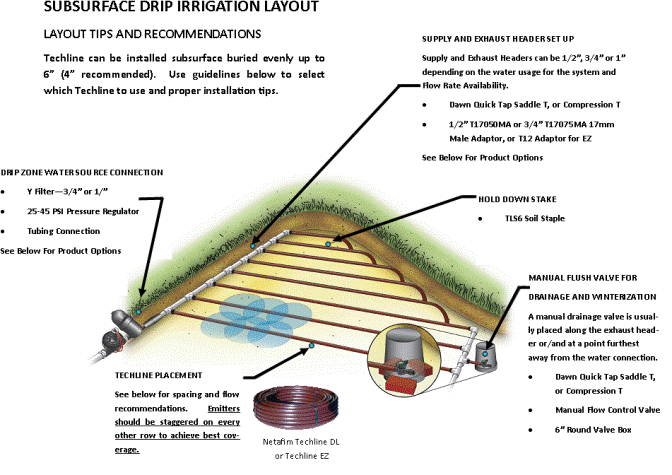| Sub Surface Lawn Irrigation Basics Drip Irrigation to most people is an efficient and effective method of watering plants and landscapes and Lawn Irrigation is usually applied using Sprinkler Systems. It may come as a surprise that the same principals and benefits of Drip Irrigation can be applied to Lawn (Turf) Irrigation using Sub-Surface Drip Irrigation. Advantages of Sub-Surface Drip Irrigation: - Strong root development.
- Even Distribution of Water throughout the watering area with evenly spaced emitters.
- No evaporation or run off of water.
- Silent and Invisible operation.
- Up to 70% more efficient than traditional turf watering methods for cost effective operation
- Inexpensive and easy installation (water needs and design layout can be done with little to no experience).
- Can be installed to a basic hose faucet (no need for connecting directly to water lines)
Below is an illustration of a typical Sub-Surface Drip Irrigation Installation using Netafim Techline CV Drip Line followed by a summary of design techniques and system components required for a typical system. These general guidelines can be used for virtually any sub-surface turf system and should give you all you need for a successful installation. Please note: When installing a sub-surface drip system for new turf some overhead traditional watering is needed to establish initial root growth before the sub surface system becomes effective. 
System Components As the image above illustrates Sub-Surface Turf Systems are basically comprised of 4 system components; - Water Source Connection - This is often referred to as a Drip Zone Source Connection and is usually comprised of a valve, filter, and pressure regulator. For Sub-Surface systems the pressure and flow rate is often low enough to replace the valve with a simple hose end timer.
- Supply and Exhaust Headers - The supply line can be either PVC or Poly Tubing but for our illustrations we will assume Poly Tubing for easy installation. These lines are the distribution lines for the Drip Line and the size of the Header is dependent upon both the water required and the water available (this is explained in more detail below). The connection from the Header to the Drip Line can be accomplished with several combinations of fittings but the easiest method is to use Quick Tap Saddles to eliminate the need for cutting Header line and to greatly reduce installation time.
- Netafim Drip Line - We recommend using Netafim Techline Drip Line (often referred to as soaker hose). This isn't the soaker hose you used to purchase at the local hardware store, but rather the Iron Man of soaker hose drip line. Techline is one of the most technologically advanced drip lines on the market today with pressure compensating, self flushing emitters built into the line with additional features such as root barrier technology and the elimination of the need for an air release valve.
- Manual Flush Valve - All Subsurface Irrigation Systems must have a flush valve that is typically located at the furthest point from the water source and more favorably at the lowest vertical point of the system for easier drainage. The system should be flushed once or twice a year by simply opening the manual valve (usually housed in a simple 6" round valve box) and running water through the system to clear debris. The valve is also used at the end of the season to drain the system which can often be accomplished with a shop vacuum with small to medium sub-surface systems.
We will illustrate in more detail common system components later in this tutorial, but first must address planning consideration for your system to ensure superior watering results. The planning is simple but necessary and includes the determination of soil type and the appropriate Netafim Techline CV , the size of the watering area, and choosing the appropriate drip line and header size. Next Step - Choosing Your Drip Line Ref 1010 | 
